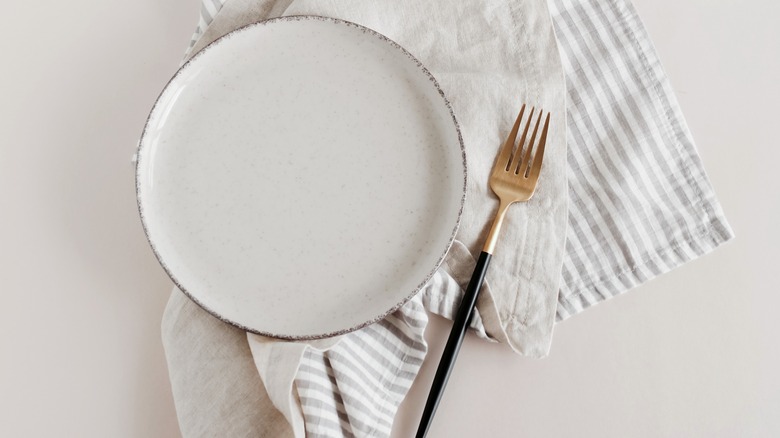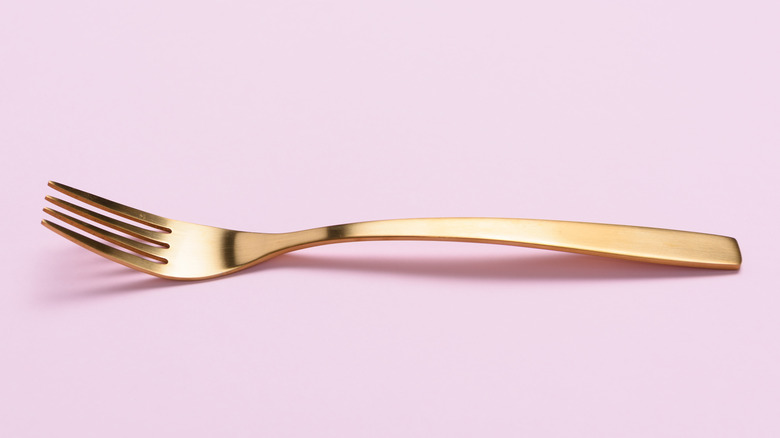Why Forks Were Once Considered An Affront To God
Those of us who love to cook put a lot of time and effort into our kitchen creations, whether our favorite dish to whip up is something simple and reliable such as a great burger, or something more elaborate and dinner party-worthy, like a classic seafood paella. We might not, however, devote as much attention to one of the purely perfunctory parts of sitting down to a meal. Namely, setting the table.
"What's there to think about?" you might be asking. After all, unless you're throwing a lavish affair that calls for fine china, several varieties of utensils, and glasses for water, wine, and coffee, then, for most occasions, you probably call it a day at a plate, a knife, and a fork. That latter utensil — the ultra-utilitarian fork that most of us likely use at breakfast, lunch, and dinner almost every single day — seems like a given, but it actually did not come into common use in the wider western world until the late Middle Ages, according to Leite's Culinaria. The outlet writes that while knives and spoons have been used at meals since ancient times, the fork was glacially slow to catch on, and was even considered an abomination against god by the Roman Catholic church.
Clergymen felt that fingers were man's 'natural forks'
According to Royal Museums Greenwich, the fork is a latecomer to humanity's eating scene. While people have used spoons and knives since ancient times, the pronged instrument we know as a fork was only rarely employed — typically to hold meat in place as it was cut, or to lift it out of a pot, much as we use a carving fork today (via Leite's Culinaria). In fact, these ancient forks pretty much resembled today's carving forks, featuring long handles and two long tines. Across the western world, diners from common folk all the way up to royalty typically dined using a knife to cut and their fingers to lift the food to their mouths, Smithsonian reports.
Though the fork was sporadically used throughout Europe by royalty and wealthy merchants, it was often viewed as overly feminine and dainty, Royal Museums Greenwich writes. And some members of the Roman Catholic clergy saw the fork as downright sinister. According to Leite's Culinaria, in 1004, Maria Argyropoulina, Greek niece of Byzantine Emperor Basil II, arrived in Venice for her marriage to Giovanni, son of Pietro Orseolo II, the Doge of Venice. She brought a case of golden forks, which were used during the wedding feast, causing one local clergy member to comment, "God in his wisdom has provided man with natural forks — his fingers. Therefore it is an insult to him to substitute artificial metal forks for them when eating."
Argyropoulina continued to be condemned even after her death
Two years after busting out her personal set of golden forks at her wedding banquet, according to Leite's Culinaria, Maria Argyropoulina died of the plague — and one religious official actually ascribed her cause of death to her use of those heathenly forks. The outlet states that Benedictine monk Peter Damian, who was later sainted by the Roman Catholic church (via Franciscan Media), wrote, "Nor did she deign to touch her food with her fingers, but would command her eunuchs to cut it up into small pieces, which she would impale on a certain golden instrument with two prongs and thus carry to her mouth. This woman's vanity was hateful to Almighty God; and so, unmistakably, did He take his revenge. For He raised over her the sword of His divine justice so that her whole body did putrefy and all her limbs began to wither."
She was struck down by god for using a fork? Public opinion in 11th-century Europe sure was brutal. And to think we modern folk use these godless utensils every single day.


